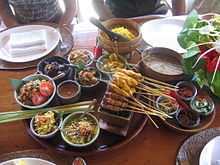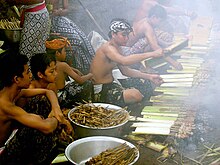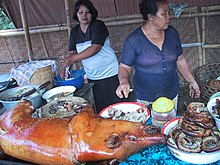Balinese cuisine

Balinese cuisine is a cuisine tradition of Balinese people from the volcanic island of Bali. Using a variety of spices, blended with the fresh vegetables, meat and fish.[1] Part of Indonesian cuisine, it demonstrates indigenous traditions, as well as influences from other Indonesian regional cuisine, Chinese and Indian. The island's inhabitants are predominantly Hindu and culinary traditions are somewhat distinct with the rest of Indonesia, with festivals and religious celebrations including many special foods prepared as the offerings for the deities, as well as other dishes consumed communally during the celebrations.

Rice, the primary grain is almost always consumed as a staple accompanied with vegetables, meat and seafood. Pork, chicken, fruit, vegetables and seafood are widely utilized, however just like most of Hindus, beef is never or rarely consumed.
Bali is a popular tourist destination, and the area has quite a lot of cooking schools with daily courses of Balinese cuisine.[2] Night markets, warungs (food stands), and fruit vendors sell local delicacies.[2] Festivals include ornately prepared foods as part of the celebrations. As a popular tourist area, many westernized foods are also available as well as other regional ethnic cuisines.
Rice

Bali has a strong rice agriculture tradition in Indonesia, as evidence through centuries old intricate network of sophisticated Subak irrigation system. The Balinese water temples regulates the water allocation of each village's ricefields in the region. Balinese Hinduism revered Dewi Sri as an important rice goddess. Her and other deities colorful effigies made from colorful sticky rice are often made during religious ceremonies.
Spices and seasonings

Basa gede, also known as basa rajang, is a spice paste that is a basic ingredient in many Balinese dishes.[3][unreliable source?] Basa gede form the cornerstone of many Balinese dishes. Its ingredients include garlic, red chili peppers, Asian shallots, nutmeg, ginger, turmeric, palm sugar, cumin, shrimp paste and salam leaves (Indonesian bay leaf).[4]
Balinese dishes are punctuated by basa genep, the typical Balinese spice mix used as the base for many curry and vegetable dishes.[5] As well as bumbu (seasoning) used as a marinade. Tabia lala manis, which is a thin soy sauce with chili peppers, and sambal matah are popular condiments.[6]
Dishes

Balinese foods include lawar (chopped coconut, garlic, chilli, with pork or chicken meat and blood), Bebek betutu (duck stuffed with spices, wrapped in banana leaves and coconut husks cooked in a pit of embers), Balinese sate known as sate lilit made from spiced mince pressed onto skewers which are often lemongrass sticks, Babi guling also known as celeng guling (a spit-roasted pig stuffed with chilli, turmeric, garlic, and ginger).[6]
In Bali, the mixed rice is called nasi campur Bali or simply nasi Bali. The Balinese nasi campur version of mixed rice may have grilled tuna, fried tofu, cucumber, spinach, tempe, beef cubes, vegetable curry, corn, chili sauce on the bed of rice. Mixed rice is often sold by street vendors, wrapped in a banana leaf.
Betutu is eaten in Bali as well as Lombok, and West Nusa Tenggara. It is a roasted poultry dish (chicken or duck) with spices. Lawar is a traditional vegetable and meat dish in Bali Vegetable and meat dish served with rice. It consists of shredded unripe jackfruit, young banana flower, a liberal amount of pork rind bits, raw pig blood. These are mashed with herbs such as lemon grass, kaffir lime leaves, shallots, and garlic. Babi guling is a Balinese-style roast pork comparable to Hawaiian luau-style pig.
Other common Indonesian dishes are easily found, such as tempe and tofu are used. Sambal dishes are also served. Bakso, a meatball or meat paste made from beef surimi, can also be found.
Beverages

Balinese coffee, Kopi Bali, and hot tea, teh panas are popular. Tea is often served with sugar (gula) and condensed milk, susu.[2] Brem is Balinese rice wine alcoholic beverage. It is made from fermented mash of black or white glutinous rice (known as Ketan) using a dry-starter, which called as Ragi tape.[7]
Ingredients

Pork, chicken, seafoods and vegetables are widely consumed.
Spices include Kaempferia galanga (galangal), shallots, garlic, turmeric, ginger and Kaffir lime are used in Balinese cuisine. Balinese 8-spice is made with white pepper, black pepper, coriander, cumin, clove, nutmeg, sesame seed, and candlenut. Palm sugar, fish paste, and basa gede (a spice paste) are used.[8]
Fruits include rambutan, mangoes, mangosteen, bananas, jackfruit, rambutan, makiza, nangka, pineapple, salak (snake fruit), duku, kelengkeng, wani (Mangifera caesia), papaya, longan, white mango (Mangifera caesia), melon, oranges, custard-apple, coconut and durian.[9]
Dishes

- Babi guling, roasted suckling pig, famous in Bali
- Betutu, steamed or roasted poultry (chicken or duck) highly seasoned. A specialty of Bali and Lombok
- Bubur Sum-Sum, rice porridge with palm sugar sauce and grated coconut.
- Bubur Injun (black rice pudding), black sticky rice with coconut milk.
- Bantal, packages of sticky rice, coconut, sugar and fruit (often bananas or sometimes orange rind or even mango essence).
- Iga Babi, Balinese pork ribs
- Kopi Luwak (Luwak coffee), also called civet coffee or “poo coffee”. It is named after the practice of weasel-like animals called civets let loose into coffee plantations at night to eat coffee berries then poop out the coffee beans which are collected, washed and roasted over a fire.[8]
- Lawar, mixed vegetables and other ingredients
- Nasi Bali, rice with various dishes
- Sate Babi (pork satay)
- Sate Lilit, spiced mince meat on a stick
- Soto Babi, pork soto
- Sayur Urab, mixed salad
- Bumbu Bali, Balinese spice of basa genep, commonly used as flavouring agent for chicken, fish or meat. Ayam bumbu Bali means chicken in Balinese spice mixture.
- Martabak Manis (dessert) A sweet, thick pancake mostly sold by street vendors in the evening with different fillings like condensed milk, chocolate sprinkles, crushed peanuts and cheese.
See also
References
- ^ "Flavours of Indonesia, Balinese Food". Destination Asia. Archived from the original on 17 August 2014. Retrieved 26 August 2014.
{{cite web}}: Unknown parameter|deadurl=ignored (|url-status=suggested) (help) - ^ a b c "Bali: The Online Travel Guide - Food". Home.mira.net. Retrieved 2013-07-01.
- ^ Bali: A Day At The Market And Cooking Class
- ^ O’Gilvie, Diana (14 October 2012). "Learning Bali's true flavors". The Jakarta Post. Retrieved 14 January 2015.
- ^ Betteridge, Ashlee (Apr 2, 2010). "Nasi Campur: Rice With a Side of Serendipity". Archived from the original on 25 May 2014. Retrieved 22 May 2014.
{{cite web}}: Unknown parameter|deadurl=ignored (|url-status=suggested) (help) - ^ a b [Traditional Balines Foods] Ehow
- ^ Bali. buykratom.us;
- ^ a b Daniel Noll and Audrey Scott (2011-07-22). "Bali Food (An Overview of Cuisine in Bali)". Retrieved 2013-07-01.
- ^ "Guide to tropical fruits in Bali". Bali Blog. 2005-03-02. Retrieved 2013-07-01.
Further reading
- Bali Unveiled: The Secrets of Balinese Cuisine - Heinz Von Holzen. Retrieved 2013-07-01.
- Street Foods of Bali - Heinz von Holzen. Retrieved 2013-07-01.
- Balinese Food: The Traditional Cuisine and Food Culture of Bali. Dr. Vivienne Kruger, Ph.D. (Tuttle Publishing, April 2014)
- Forty Delicious Years 1974-2014. Murni's Warung, Ubud, Bali: From Toasted Sandwiches to Balinese Smoked Duck. By Jonathan Copeland, Rob Goodfellow, and Peter O'Neill (Orchid Press, Jun 1, 2014)
- Secrets of Bali, Fresh Light on the Morning of the World, Jonathan Copeland and Ni Wayan Murni,(Orchid Press, September 2010)
External links
 Media related to Cuisine of Bali at Wikimedia Commons
Media related to Cuisine of Bali at Wikimedia Commons
